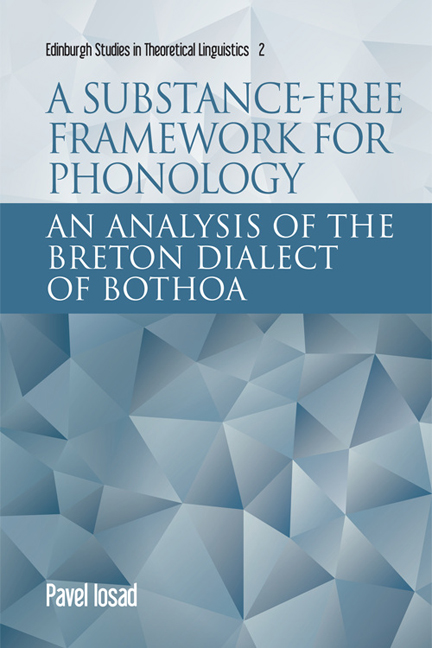Book contents
- Frontmatter
- Contents
- Acknowledgements
- Chapter 1 Introduction
- Chapter 2 Conceptual foundations of substance-free phonology
- Chapter 3 Representational assumptions
- Chapter 4 Computational assumptions
- Chapter 5 Complexity and markedness in substance-free phonology
- Chapter 6 The Breton language
- Chapter 7 Segments and representations
- Chapter 8 Suprasegmental phonology
- Chapter 9 The phonology of vowels
- Chapter 10 The phonology of consonants: palatalisation and gliding
- Chapter 11 Laryngeal phonology
- Chapter 12 Conclusion
- References
- Index
Chapter 8 - Suprasegmental phonology
Published online by Cambridge University Press: 20 December 2017
- Frontmatter
- Contents
- Acknowledgements
- Chapter 1 Introduction
- Chapter 2 Conceptual foundations of substance-free phonology
- Chapter 3 Representational assumptions
- Chapter 4 Computational assumptions
- Chapter 5 Complexity and markedness in substance-free phonology
- Chapter 6 The Breton language
- Chapter 7 Segments and representations
- Chapter 8 Suprasegmental phonology
- Chapter 9 The phonology of vowels
- Chapter 10 The phonology of consonants: palatalisation and gliding
- Chapter 11 Laryngeal phonology
- Chapter 12 Conclusion
- References
- Index
Summary
In this chapter I offer an analysis of some aspects of suprasegmental phonology in Bothoa Breton. I focus on three issues:
• Stress placement. Unlike most other Brythonic varieties, stress in Bothoa Breton is to a certain extent lexical and therefore unpredictable. However, some non-trivial generalisations regarding its placement can still be extracted, and they provide some important insights into the stratal model of morphology–phonology interactions in the language. I also propose that a system that appears to be potentially analysable as a ‘pitch accent’ pattern in fact derives from differences in metrical structure.
• The role of syllable structure in phonotactic restrictions. As I show in this chapter, an explicit understanding of syllabic structures that are (dis)allowed in the language offers diagnostics for the phonological status of some important patterns.
• The interaction between consonant quality and vowel length. Here, again, Bothoa Breton differs from most other Brythonic varieties, and this difference will play an important role in the analysis of laryngeal phonology in Chapter 11.
Stress
The stress system of Bothoa Breton differs significantly from that of other varieties of Brythonic Celtic. In Welsh (and Cornish) and most varieties of Breton, stress falls regularly on the penultimate syllable, and (barring a handful of modern borrowings) is in any case restricted to a two-syllable window at the right edge of a word. In south-eastern (Vannetais) varieties of Breton, on the other hand, stress regularly falls on the final syllable; there is no agreement in the literature on whether this represents a retention of the Old Brythonic pattern of final stress or an innovation, possibly induced through contact with French. The dialect of Bothoa, which Humphreys (1995) classes as a Cornouaillais variety, also shares a number of features with Vannetais, which is unsurprising given its location. One of the ways in which this Vannetais presence in manifested is the stress system, which it shares with some other varieties in the region (Plourin 1985). In addition, some of the characteristics of its prosodic system are quite unusual even within the wider Brythonic context.
Types of stress
According to Humphreys (1995), stressed vowels are characterised by greater intensity, greater duration and rising pitch (this latter especially pronounced on final syllables).
- Type
- Chapter
- Information
- A Substance-free Framework for PhonologyAn Analysis of the Breton Dialect of Bothoa, pp. 95 - 123Publisher: Edinburgh University PressPrint publication year: 2017



